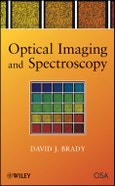This is the first text to present an integrated view of the optical and mathematical analysis tools necessary to understand computational optical system design. It presents the foundations of computational optical sensor design with a focus entirely on digital imaging and spectroscopy. It systematically covers:
-
Coded aperture and tomographic imaging
-
Sampling and transformations in optical systems, including wavelets and generalized sampling techniques essential to digital system analysis
-
Geometric, wave, and statistical models of optical fields
-
The basic function of modern optical detectors and focal plane arrays
-
Practical strategies for coherence measurement in imaging system design
-
The sampling theory of digital imaging and spectroscopy for both conventional and emerging compressive and generalized measurement strategies
-
Measurement code design
-
Linear and nonlinear signal estimation
The book concludes with a review of numerous design strategies in spectroscopy and imaging and clearly outlines the benefits and limits of each approach, including coded aperture and imaging spectroscopy, resonant and filter-based systems, and integrated design strategies to improve image resolution, depth of field, and field of view.
Optical Imaging and Spectroscopy is an indispensable textbook for advanced undergraduate and graduate courses in optical sensor design. In addition to its direct applicability to optical system design, unique perspectives on computational sensor design presented in the text will be of interest for sensor designers in radio and millimeter wave, X-ray, and acoustic systems.
Table of Contents
Preface.Acknowledgments.
1. Past, present and future.
1.1 Three revolutions.
1.2 Computational imaging.
1.3 Overview.
1.4 The fourth revolution.
Problems.
2. Geometric imaging.
2.1 Visibility.
2.2 Optical elements.
2.3 Focal imaging.
2.4 Imaging systems.
2.5 Pinhole and coded aperture imaging.
2.6 Projection tomography.
2.7 Reference structure tomography.
Problems.
3. Analysis.
3.1 Analytical tools.
3.2 Fields and transformations.
3.3 Fourier analysis.
3.4 Transfer functions and filters.
3.5 The Fresnel transformation.
3.6 The Whittaker-Shannon sampling theorem.
3.7 Discrete analysis of linear transformations.
3.8 Multiscale sampling.
3.9 B-splines.
3.10 Wavelets.
Problems.
4. Wave imaging.
4.1 Waves and fields.
4.2 Wave model for optical fields.
4.3 Wave propagation.
4.4 Diffraction.
4.5 Wave analysis of optical elements.
4.6 Wave propagation through thin lenses.
4.7 Fourier analysis of wave imaging.
4.8 Holography.
Problems.
5. Detection.
5.1 The Optoelectronic interface.
5.2 Quantum mechanics of optical detection.
5.3 Optoelectronic detectors.
5.3.1 Photoconductive detectors.
5.3.2 Photodiodes.
5.4 Physical characteristics of optical detectors.
5.5 Noise.
5.6 Charge coupled devices.
5.7 Active pixel sensors.
5.8 Infrared focal plane arrays.
Problems.
6. Coherence imaging.
6.1 Coherence and spectral fields.
6.2 Coherence propagation.
6.3 Measuring coherence.
6.4 Fourier analysis of coherence imaging.
6.5 Optical coherence tomography.
6.6 Modal analysis.
6.7 Radiometry.
Problems.
7. Sampling.
7.1 Samples and pixels.
7.2 Image plane sampling on electronic detector arrays.
7.3 Color imaging.
7.4 Practical sampling models.
7.5 Generalized sampling.
Problems.
8. Coding and inverse problems.
8.1 Coding taxonomy.
8.2 Pixel coding.
8.3 Convolutional coding.
8.4 Implicit coding.
8.5 Inverse problems.
Problems.
9. Spectroscopy.
9.1 Spectral measurements.
9.2 Spatially dispersive spectroscopy.
9.3 Coded aperture spectroscopy.
9.4 Interferometric Spectroscopy.
9.5 Resonant spectroscopy.
9.6 Spectroscopic filters.
9.7 Tunable filters.
9.8 2D spectroscopy.
Problems.
10. Computational imaging.
10.1 Imaging systems.
10.2 Depth of field.
10.3 Resolution.
10.4 Multiple aperture imaging.
10.5 Generalized sampling revisited.
10.6 Spectral imaging.
Problems.
References.
Samples

LOADING...








